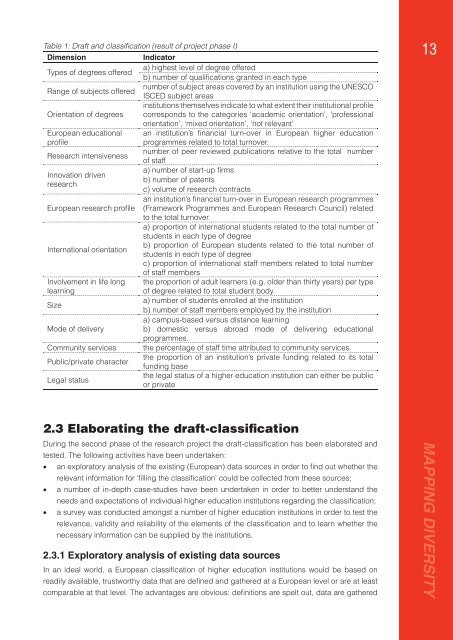Mapping Diversity: Developing a European Classification of ... - U-Map
Mapping Diversity: Developing a European Classification of ... - U-Map
Mapping Diversity: Developing a European Classification of ... - U-Map
You also want an ePaper? Increase the reach of your titles
YUMPU automatically turns print PDFs into web optimized ePapers that Google loves.
Table 1: Draft and classifi cation (result <strong>of</strong> project phase I)<br />
Dimension<br />
Types <strong>of</strong> degrees <strong>of</strong>fered<br />
Range <strong>of</strong> subjects <strong>of</strong>fered<br />
Orientation <strong>of</strong> degrees<br />
<strong>European</strong> educational<br />
pr<strong>of</strong>i le<br />
Research intensiveness<br />
Innovation driven<br />
research<br />
<strong>European</strong> research pr<strong>of</strong>i le<br />
International orientation<br />
Involvement in life long<br />
learning<br />
Size<br />
Mode <strong>of</strong> delivery<br />
Community services<br />
Public/private character<br />
Legal status<br />
Indicator<br />
a) highest level <strong>of</strong> degree <strong>of</strong>fered<br />
b) number <strong>of</strong> qualifi cations granted in each type<br />
number <strong>of</strong> subject areas covered by an institution using the UNESCO<br />
ISCED subject areas<br />
institutions themselves indicate to what extent their institutional pr<strong>of</strong>i le<br />
corresponds to the categories ‘academic orientation’, ‘pr<strong>of</strong>essional<br />
orientation’, ‘mixed orientation’, ‘not relevant’<br />
an institution’s fi nancial turn-over in <strong>European</strong> higher education<br />
programmes related to total turnover.<br />
number <strong>of</strong> peer reviewed publications relative to the total number<br />
<strong>of</strong> staff<br />
a) number <strong>of</strong> start-up fi rms<br />
b) number <strong>of</strong> patents<br />
c) volume <strong>of</strong> research contracts<br />
an institution’s fi nancial turn-over in <strong>European</strong> research programmes<br />
(Framework Programmes and <strong>European</strong> Research Council) related<br />
to the total turnover.<br />
a) proportion <strong>of</strong> international students related to the total number <strong>of</strong><br />
students in each type <strong>of</strong> degree<br />
b) proportion <strong>of</strong> <strong>European</strong> students related to the total number <strong>of</strong><br />
students in each type <strong>of</strong> degree<br />
c) proportion <strong>of</strong> international staff members related to total number<br />
<strong>of</strong> staff members<br />
the proportion <strong>of</strong> adult learners (e.g. older than thirty years) per type<br />
<strong>of</strong> degree related to total student body.<br />
a) number <strong>of</strong> students enrolled at the institution<br />
b) number <strong>of</strong> staff members employed by the institution<br />
a) campus-based versus distance learning<br />
b) domestic versus abroad mode <strong>of</strong> delivering educational<br />
programmes.<br />
the percentage <strong>of</strong> staff time attributed to community services<br />
the proportion <strong>of</strong> an institution’s private funding related to its total<br />
funding base<br />
the legal status <strong>of</strong> a higher education institution can either be public<br />
or private<br />
13<br />
2.3 Elaborating the draft-classification<br />
During the second phase <strong>of</strong> the research project the draft-classifi cation has been elaborated and<br />
tested. The following activities have been undertaken:<br />
• an exploratory analysis <strong>of</strong> the existing (<strong>European</strong>) data sources in order to fi nd out whether the<br />
relevant information for ‘fi lling the classifi cation’ could be collected from these sources;<br />
• a number <strong>of</strong> in-depth case-studies have been undertaken in order to better understand the<br />
needs and expectations <strong>of</strong> individual higher education institutions regarding the classifi cation;<br />
• a survey was conducted amongst a number <strong>of</strong> higher education institutions in order to test the<br />
relevance, validity and reliability <strong>of</strong> the elements <strong>of</strong> the classifi cation and to learn whether the<br />
necessary information can be supplied by the institutions.<br />
2.3.1 Exploratory analysis <strong>of</strong> existing data sources<br />
In an ideal world, a <strong>European</strong> classifi cation <strong>of</strong> higher education institutions would be based on<br />
readily available, trustworthy data that are defi ned and gathered at a <strong>European</strong> level or are at least<br />
comparable at that level. The advantages are obvious: defi nitions are spelt out, data are gathered<br />
MAPPING DIVERSITY

















